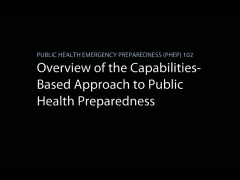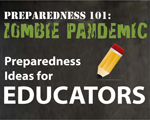Funding and Guidance for State and Local Health Departments
 CDC plays a pivotal role in ensuring that state and local public health systems are prepared for public health emergencies because of its unique abilities to respond to infectious, occupational, or environmental incidents that affect the public's health. CDC's Office of Public Health Preparedness and Response, Division of State and Local Readiness, administers funds for preparedness activities to state and local public health systems through the Public Health Emergency Preparedness (PHEP) cooperative agreement. Through the PHEP, CDC helps public health departments strengthen their abilities to respond to all types of public health incidents and build more resilient communities.
CDC plays a pivotal role in ensuring that state and local public health systems are prepared for public health emergencies because of its unique abilities to respond to infectious, occupational, or environmental incidents that affect the public's health. CDC's Office of Public Health Preparedness and Response, Division of State and Local Readiness, administers funds for preparedness activities to state and local public health systems through the Public Health Emergency Preparedness (PHEP) cooperative agreement. Through the PHEP, CDC helps public health departments strengthen their abilities to respond to all types of public health incidents and build more resilient communities.
PHEP efforts support the National Response Framework (NRF) , which guides how the nation responds to all types of hazards including infectious disease outbreaks; natural disasters; biological, chemical, and radiological incidents; and explosions.
There are 62 PHEP cooperative agreement awardees:
- All 50 states
- Four major metropolitan areas (Chicago, Los Angeles County, New York City, and Washington, D.C.)
- Eight U.S. territories and freely associated states (American Samoa, Guam, U.S. Virgin Islands, Northern Mariana Islands, Puerto Rico, Federated States of Micronesia, Republic of the Marshall Islands, and Republic of Palau).
Public Health Emergency Preparedness Cooperative Agreements
The Public Health Emergency Preparedness (PHEP) cooperative agreement is a critical source of funding for state, local, tribal, and territorial public health departments. Since 2002, the PHEP cooperative agreement has provided nearly $9 billion to public health departments across the nation to upgrade their ability to effectively respond to a range of public health threats, including infectious diseases, natural disasters, and biological, chemical, nuclear, and radiological events. Preparedness activities funded by the PHEP cooperative agreement are targeted specifically for the development of emergency-ready public health departments that are flexible and adaptable.
In response to the 2009 H1N1 influenza pandemic, CDC also administered funding through the Public Health Emergency Response grant to upgrade state and local preparedness and response capacity during the pandemic. Recipients included the 62 PHEP awardees.
Guidance and Technical Assistance. In addition to funding, CDC provides annual guidance and technical assistance to assist state, territorial, and local health departments with their strategic planning to strengthen their public health preparedness capabilities. Technical assistance includes CDC public health expertise, standards for developing priority preparedness capabilities, and expertise for conducting exercises and meeting performance goals.
2012 PHEP Cooperative Agreement Guidance/Budget Period 1
- Funding Opportunity Announcement CDC-RFA-TP12-1201 – Fiscal Year 2012 (Budget Period 1)
- Funding Table
- PHEP BP1 Performance Measure Specifications and Implementation Guidance
- PHEP BP1 Performance Measure At-A-Glance
2011 PHEP Cooperative Agreement Guidance/Budget Period 11
- Program Announcement TP11-1101CONT11 - FY 2011 (Budget Period 11)
- Funding Table
- Performance Measures Specifications and Implementation Guidance (Budget Period 11)
2004-2010 PHEP Cooperative Agreement Guidance Archive
- Archive for 2004 through 2008 and archive for 2009 and 2010 — guidance/technical assistance and funding documents from previous years
National Standards for Public Health Preparedness Capabilities
 To help public health departments with their strategic planning, CDC identified 15 public health preparedness capabilities to serve as national public health preparedness standards. State and local jurisdictions can use CDC's Public Health Preparedness Capabilities: National Standards for State and Local Planning to better organize their work and identify the capabilities they have the resources to build or sustain. These standards help ensure that federal preparedness funds are directed to priority areas within individual jurisdictions.
To help public health departments with their strategic planning, CDC identified 15 public health preparedness capabilities to serve as national public health preparedness standards. State and local jurisdictions can use CDC's Public Health Preparedness Capabilities: National Standards for State and Local Planning to better organize their work and identify the capabilities they have the resources to build or sustain. These standards help ensure that federal preparedness funds are directed to priority areas within individual jurisdictions.
The 2011 PHEP cooperative agreement guidance assists PHEP awardees in demonstrating measurable and sustainable progress toward achieving the 15 public health preparedness capabilities and other activities that promote safer and more resilient communities.
Training Videos
CDC is developing a series of training guides to assist state and local health departments in achieving the 15 public health preparedness capabilities as outlined in the 2011 PHEP cooperative agreement guidance. View the following videos on CDC's Public Health Preparedness Capabilities: National Standards for State and Local Planning:
Contact Us:
- Centers for Disease Control and Prevention
1600 Clifton Rd
Atlanta, GA 30333 - 800-CDC-INFO
(800-232-4636)
TTY: (888) 232-6348 - Contact CDC–INFO






